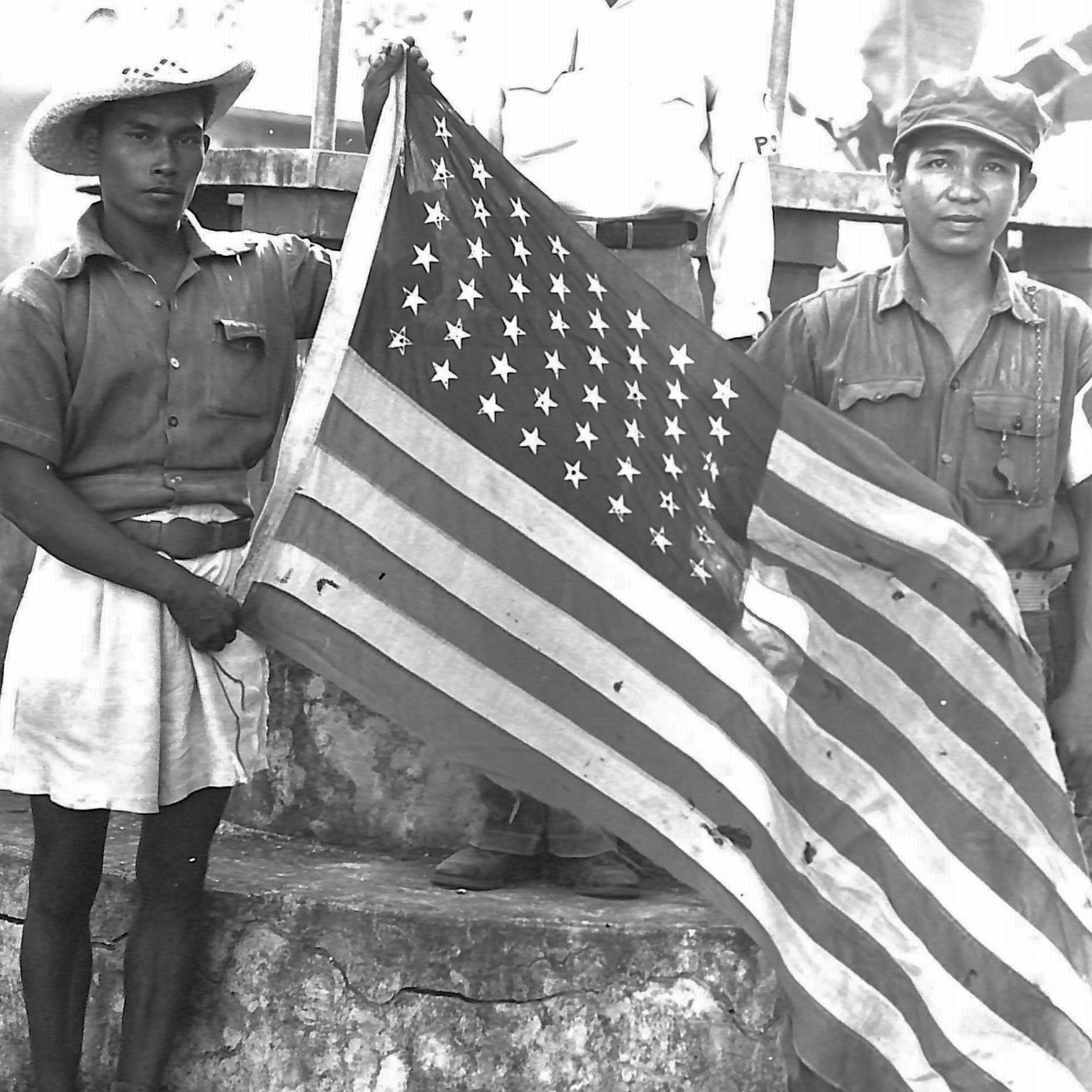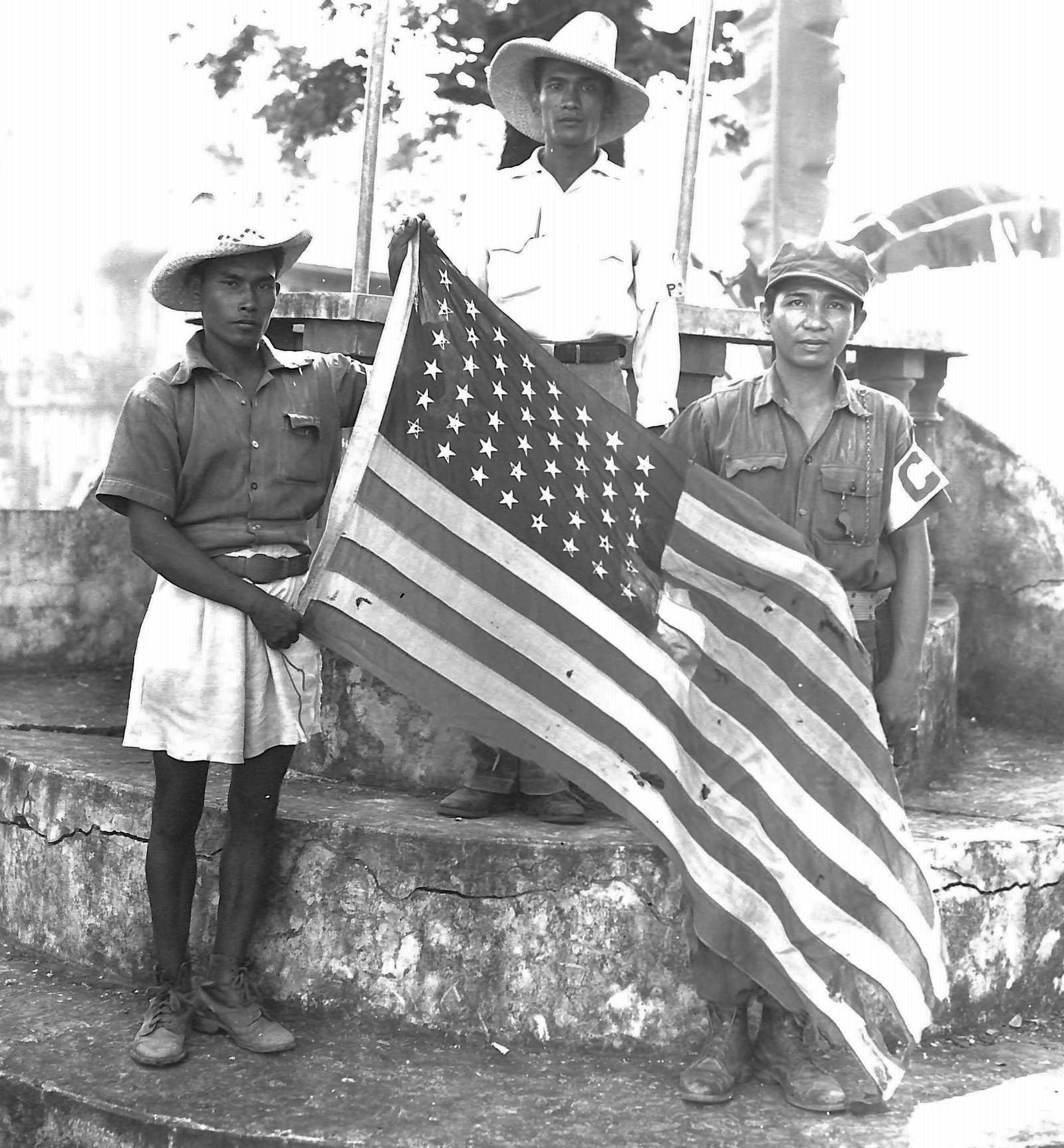Explainer 12:

Filipino Guerrillas with American Flag
Students analyze a photo of Filipino guerrillas holding an American flag to consider the experiences and expectations of Filipinos who served in the U.S. military during World War II.
Teacher Background
When U.S. forces withdrew from the Philippines in May 1942, General MacArthur famously promised, “I shall return.” For the next three years, Filipino guerrillas risked everything to liberate their homeland from the Japanese. Guerrillas sabotaged Japanese military equipment and infrastructure, and targeted Japanese soldiers on patrol with sniper attacks, hit-and-run skirmishes and kidnappings. Spies gathered intelligence and covertly passed it along to American forces. When the U.S. began its invasion to retake the Philippines on the island of Leyte in October 1944, guerrillas offered reconnaissance and logistical support, while USAFFE forces smuggled in weapons and medicine. Over the next six months, guerrillas joined forces with the returning Americans to defeat the Japanese.
Guerrillas fought the Japanese without knowing whether and how their military service would be formally recognized. But in 1944, as the liberation of the Philippines began, Filipino President Sergio Osmeña and U.S. General Douglas MacArthur issued an order that incorporated about 70,000 guerrillas into the Philippine Commonwealth Army and thus making them official USAFFE soldiers.
Filipinos, whether trained members of the Philippine Scouts, members of the Philippine Commonwealth Army, or guerrillas, served bravely and heroically. By the end of the war, more than 200,000 Filipinos had performed some sort of military service, though many were in unofficial guerrilla groups. At that point, as members of the U.S. armed forces, they were entitled to certain benefits, including pensions and healthcare, other veterans benefits (such as those provided by the G.I. Bill), and, per the terms of the 1940 Nationality Act, the opportunity to naturalize as U.S. citizens if they desired. However, the U.S. betrayed its promise by passing the Rescission Act of 1946. The Rescission Act determined that Filipinos had fought “with” and not “in” U.S. armed forces, and therefore were not eligible for any veterans benefits.
This Explainer uses a photo of Filipino guerrillas holding a U.S. flag to consider the experiences and expectations of Filipinos who served in USAFFE. It can be paired with oral histories and animations from the Under One Flag exhibit to understand the contributions of Filipino guerrillas during the war, or taught with the Rescission Act, to consider the theme of promises made/promises broken.
Suggested Teaching Strategies
- Ask students to look carefully at the image, noting details such as the poses and expressions of the Filipino guerrillas, their clothes and the condition of the flag. What do they think is going on in the photo? What aspects of guerrilla life can they deduce from evidence in the photo?
- What additional information does the original caption provide? How does knowing its creator and date of creation add to the picture?
- Ask students to imagine (or use prior knowledge to determine) what expectations Filipinos like those pictured might have had of the U.S. at the close of the war. In other words, what promises are implied by the photo?
- Spend some time asking students to assess the intended meaning of the photographer (based on who created it and what it depicts) versus how we might read this image today, knowing that the U.S. failed to provide benefits to Filipino veterans.
- Optional extension: Have students explore the animations, primary sources, oral histories and other information about guerrilla contributions to the war in the Under One Flag exhibit, and select a person or event to share with the class.
Curriculum Standards
Common Core: Middle School
- CCSS.ELA-LITERACY.RH.6-8.1 Cite specific textual evidence to support analysis of primary and secondary sources.
- CCSS.ELA-LITERACY.RH.6-8.2 Determine the central ideas or information of a primary or secondary source; provide an accurate summary of the source distinct from prior knowledge or opinions.
Common Core: High School
- CCSS.ELA-LITERACY.RH.11-12.1 Cite specific textual evidence to support analysis of primary and secondary sources, connecting insights gained from specific details to an understanding of the text as a whole.
- CCSS.ELA-LITERACY.RH.11-12.2 Determine the central ideas or information of a primary or secondary source; provide an accurate summary that makes clear the relationships among the key details and ideas.
Filipino guerrillas with American Flag, circa 1945
This photo was taken shortly after the liberation of the Philippines. The original caption reads “US. Flag was hidden for three years in Malsiqui Luzon, Capt. of Pinlae unit with two other guerrillas.”

Source: U.S. Army Signal Corps, January 1945.
Focus Questions
- What do you see? What’s going on in this photo?
- Pay attention to details like clothing, posture, expressions, the condition of the flag and more.
- Who created this image? Why might it have been created?
- Why would the US flag have been hidden during the war? Why would guerrillas have saved it?
- At the end of the war, what expectations did Filipinos who had fought the Japanese have of the Americans?
- Is this image an example of propaganda? If so, what was the meaning it was intended to convey? Do you read it differently than its creators may have intended?
